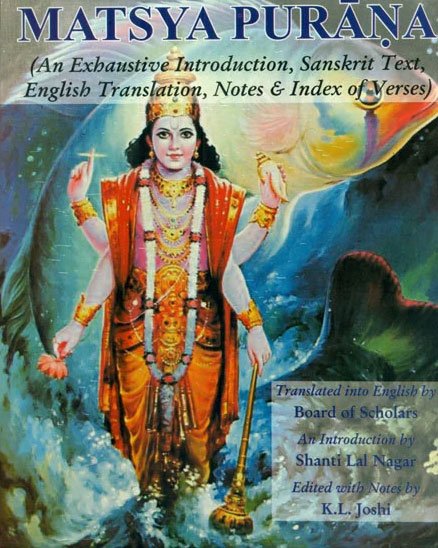The Matsya Purana (critical study)
by Kushal Kalita | 2018 | 74,766 words | ISBN-13: 9788171103058
This page relates ‘Samkhya philosophy in the Matsyapurana’ of the English study on the Matsya-purana: a Sanskrit text preserving ancient Indian traditions and legends written in over 14,000 metrical verses. In this study, the background and content of the Matsyapurana is outlined against the cultural history of ancient India in terms of religion, politics, geography and architectural aspects. It shows how the encyclopedic character causes the text to deal with almost all the aspects of human civilization.
Part 3 - Sāṃkhya philosophy in the Matsyapurāṇa
Most of the Purāṇas deal with Sāṃkhya philosophy. The Bhāgavatapurāṇa discusses the philosophy of Kapila. It has given description of the twenty five principles.[1] The Viṣṇupurāṇa describes the process of evolution.[2] The Brahmapurāṇa refers to Pradhāna or Avyakta as the cause of the Universe.[3] The Matsyapurāna has dealt with the Sāṃkhya philosophy in its several chapters. According to this Purāṇa the word sāṃkhya is derived from the word saṃkhyā. The system is so called because here numbers are enumerated.[4] Kapila, the advocate of Sāṃkhya school of philosophy is introduced as Sāṃkhyacārya. [5] He is also praised as the lord of the ascetics. It is said in the 273rd chapter of Matsyapurāṇa that Lord Viṣṇu destroys in the shape of wisdom and knowledge of Kapila the darkness of ignorance.[6]
There are several Sāṃkhyan cosmogenic texts in the Matsyapurāṇa. In the third chapter, the Matsyapurāṇa describes the creation process from Prakṛti. The description corresponds to a great extent to the Sāṃkhya theory of evolution. Prakṛti, also called avyakta and Pradhāna is described here as the equilibrium of three guṇas[7] as in the Sāṃkhya system. The evolution of mahat and other principle up to the tanmātrās are the same as Sāṃkhya philosophy. However, there is some difference regarding the production of the mahābhūtas. They are created by mind. All these have been described here under the heading Theory of Creation. In Sāṃkhya philosophy Puruṣa and Prakṛti are regarded as independent principles. But in the Matsyapurāṇa, it is said that Puruṣa, who is also called jīvātmā, under the control of Īśvara’s will.[8] In the 123rd chapter of the Matsyapurāṇa also, references to avyakta, mahat, ahaṃkāra etc. are found. It is said there -
The mahātattva and others are called vikāra and vikārin in turn in relation to the support each gives and takes from the other.[9] The earth and other mahābhūtas see vikāra only. They are limited and produced from the other and upheld by it. They are held together by their mutual attraction. Though separate they look wilded together by mutual contact. Of these elements earth, water, fire, and air are well defined (viśeṣa). The creation of the universe depends on their existence. The origin of life depends on these tattvas, as without them there can be no life and action. Thus these elements, viz., mahat, ahaṃkāra etc. are both cause and effect.[10] This description corresponds the Sāṃkhya view that among the twenty four tattvas some are cause only, some both cause and effect and some are only effect.[11]
Footnotes and references:
[1]:
Bhāgavatapurāṇa, III.25.31
[2]:
Viṣṇupurāṇa, I.2.23
[3]:
Brahmapurāṇa. 232.33-47
[4]:
sāṃkhyaṃsaṃkhyātmakatvāccakapilādibhirucyate/ Matsyapurāṇā, 3.29
[5]:
Ibid., 171.4
[6]:
Ibid., 244.31
[7]:
Ibid., 3.14
[8]:
Matsyapurāṇā, 3.28
[9]:
Ibid.,50.53
[10]:
Ibid.,123.49-61
[11]:
